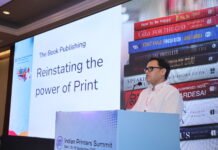Web offset newspaper press manufacturers globally continue to face huge challenges as the newspaper industry shrinks in the developed economies and growth slows down in the emerging markets in competition not just with television, radio and the internet but also with social media. Large newspaper printing plants everywhere are turning into white elephants when the need is for economical 2 x 1 press lines that can simply print high quality colour pages in smaller quantities. Manugraph, one of the leading single width web offset press manufacturers in the world, has come up with a newly designed compact 2 x1 press for which India is both the ideal testing ground and a strong potential market. We spoke to Manugraph’s joint managing director Pradeep Shah recently about this development.
The Indian economy has experienced two successive bad years, and that goes for the newspaper industry too. Managing to survive in rough times, in its own innovative way, the Indian newspaper industry has spread its footprint wider instead of shrinking, making the bigger presses work harder covering more area and pushing their older and smaller presses into the smaller cities and towns — those with just a million people. In spite of the bad times, the industry has actually grown and broken into new territories — producing more color pages then ever before. However, both domestic and global news publishers have put the brakes on capital investment in the past two years.
Manugraph produces a 4 x 1 web offset press at 70,000 copies an hour, and several types of 2 x1 towers and press configurations including autopasters and folders at speeds from 60,000, 50,000, to 36,000 and 25,000
broadsheet newspaper copies an hour. However, it is the demand for color pages in multiple locations that drives an Indian daily newspaper’s success. More color pages are needed but at circulations that are generally below 75,000 copies a day and often not more than 50,000 or even 25,000 copies in a single centre.
Instead of stripping down either its Cityline 4-Hi tower or its M360 towers, the company decided to develop a new compact tower for 4-color process printing on both sides of the web. The
new Manugraph Ecoline has been designed by the company’s R&D team based on the company’s learning from its manufacture of the Cityline Express and M360 4-Hi color towers with the idea of single level operation.
The 2.6 metre high Ecoline color tower has no second level gallery.
Initially the press will be manufactured to handle Indian broadsheet dailies that typically have a web-width of 700 and are looking at a 533 or 546 mm cut-offs. The components have been resized with a new ink train and a new mist dampening system. Initially, the towers will be produced in a gear driven shafted version at 25,000 copies an hour which Manugraph’s and its customers consider a starting point for the new press.
The Ecoline which has already undergone a couple of rounds of testing is now looking at Beta-site testing over the next three or four
months with customer installations beginning in Q1 of 2015. After the installation of the first four or five presses, which Shah estimates could happen by the middle of next year, Manugraph will look at expanding the web width to 915 mm for the book printing market and at perhaps increasing the speed.
“The Press will have all the standard features of safety and operational efficiency that Manugraph has been traditionally known for, but will be compact and spartan in effect and have 3 to 4% less paper wastage, consume less ink and energy and importantly with a smaller height be easier to operate with less manpower,” says Pradeep Shah. The new Ecoline 4-color tower has a single piece sideframe and together with its reduced size components and getting rid of the gallery structure means simpler one-level operation and an overall saving in cost and space.
Shah adds that, “Newspapers have
accepted Manugraph as a quality supplier, so customers know that our press will print quality color. Instead of making a stripped down model we decided to design a new machine. It is a completely new design and includes an option for an autopaster, and since we don’t need so much wiring for the smaller tower, it will have a mini PLC and a smaller console. The Beta testing of the press will take place in the next three to four months and the first machine should hit the market during the January-March quarter of 2015. We could go to a higher speed of 30,000 copies an hour after the installation of four or five machines. With its scalable design we could even produce a footprint-shaftless Ecoline tower.”
Pradeep Shah concludes by saying that the new Ecoline is looking at all newspaper markets and not just tier-3 cities in India. “We are looking at tier-2 markets as well,” he says. “Newspapers all over the world are looking at their large plants with 4 x 2 presses as white elephants. They are capitalizing their real estate in centres and moving to the outskirts with smaller plants with a 2 x1 press that can produce high quality color newspapers. The time has come to cut all costs. Our printing industry is going through tough times and it would be foolish to talk about mega projects. Manugraph customers and not just in India, want a smaller and simpler product.













